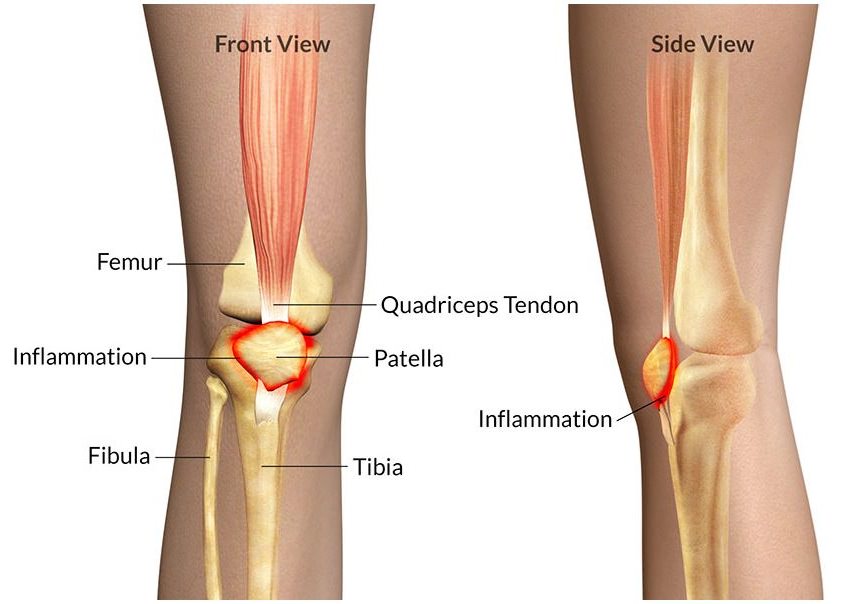Kneecap pain is one of the commonest complaints in people of all ages. Mostly, this kind of knee pain is short-lived and goes away as we continue with our normal activities. However, sometimes it is more troublesome and interferes with normal life and sport. It is more common in girls and women, and overall more in adolescents.
This pain condition is made up of a group of symptoms patients complain of, but there is no agreement amongst doctors, surgeons or physiotherapists about the cause. It is likely that several causes are present in cases, with differing degrees of each.
Patella Anatomy
The patella or kneecap is a sesamoid bone, a bone that is located within the tendon of a muscle. It makes a joint with the large condyles of the femur at the knee joint. The patella runs in a track in the groove between the condyles. The patella acts as a fulcrum to increase the contraction force of the quadriceps muscle up to 50%.
The muscles and fibrous tissue structures on each side of the bone maintain normal tracking of the patella. Disruption of this balance may be one of the causes of patellofemoral pain.
Symptoms of Patellofemoral Pain Syndrome
- Pain mostly at the front of the knee
- Pain may be achy and dull or sharp
- Crunching of the kneecap may be present, with or without pain
- The knee may give away at times, with pain
- Worse on stairs, hiking and squatting down. May be particularly worse walking downhill or downstairs
- Worse on holding the knee in one position for a period of time – the “theatre sign” or “movie-goer’s knee”. The person will want to regularly straighten the knee to relieve the pain.
Causes of Patellofemoral Pain Syndrome
The body structure of a person may make them more likely to suffer kneecap pain. Examples are hypermobility of the knee, bow-leg or knock-knee, flat feet, hamstring tightness and other postural abnormalities.
A sudden increase in physical activity, or falling on the kneecap, can also bring on pain of this kind. Excessive joint loads, either repeated over time or extreme loads at any one time, may be a trigger for this kind of pain. It is not clear whether inflammation is present in most cases.
Treatment of Patellofemoral Pain Syndrome
Physiotherapy is successful for many cases of anterior knee pain and focuses on altering any lack of flexibility and improving muscle weakness. Physiotherapists may work on:
- Activity modification – eliminate or decrease aggravating activities
- Increasing quadriceps muscle strength, particularly of the vastus medialis obliquus, the teardrop muscle just above the knee on the inside (although selective strengthening of a particular part of the quadriceps may not be possible). General strengthening of these thigh muscles has been shown to reduce pain symptoms, along with advice and information.
- Strengthening of the pelvic and hip muscles have shown positive effects when combined with thigh muscle strengthening.
- Stretching out tight fibrous tissue structures
- The use of a purpose-designed brace
- Stretching tight muscles such as the calf and hamstring muscles
- Using orthotics to correct postural abnormalities of the feet
- Balance and joint position sense
Patients may need to keep up the strengthening, flexibility and joint position sense exercise programme over the long term. Corrective orthotics may also be appropriate as an on-going treatment.
Surgery for Patellofemoral Pain Syndrome
Surgery for kneecap pain is uncommon and only appropriate when the patient’s symptoms have not settled after an intensive physiotherapy programme and some considerable time has elapsed.
Various surgical procedures are available such as shaving the cartilage of the patella, releasing tight fibrous structures on the outer side, relocating the tibial tuberosity (the bump below the knee) to realign the muscle forces. Removal of the patella, called patellectomy, is rarely performed and may significantly reduce the power of the quadriceps muscles. Overall, surgery has not been shown to be of benefit over conservative treatment such as physiotherapy.
References:
- Patellofemoral Pain Syndrome. Physiopedia. http://www.physio-pedia.com/Patellofemoral_Pain_Syndrome
- Patellofemoral Syndrome – Medscape. http://emedicine.medscape.com/article/308471-overview
- Kooiker L, Van De Port IG, Weir A, et al. Effects of physical therapist-guided quadriceps-strengthening exercises for the treatment of patellofemoral pain syndrome: a systematic review. J Orthop Sports Phys Ther. 2014 Jun. 44(6):391-B1.
- Peters JS, Tyson NL. Proximal exercises are effective in treating patellofemoral pain syndrome: a systematic review. Int J Sports Phys Ther. 2013 Oct. 8(5):689-700.
Last Review Date: 09-02-2020
Next Review Date: 06-02-2022

